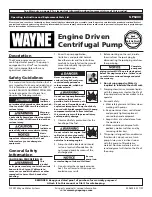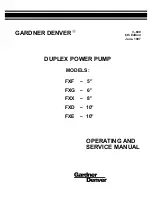
14
piston with lithium grease.
2.
If removed, re-install the M5 bolt in the tapped center hole of
the piston.
3. Align the piston with the bore opening and carefully reinstall
it in the bore.
4. Using a suitable needle nose pliers, apply fi rm pressure to
the head of the M5 bolt until the piston has bottomed out in
the bore of the housing. Then, unscrew and remove the M5
bolt.
5.
Align the end cap with the bore opening and position it in the
bore.
6. Using a suitable needle nose pliers, apply fi rm pressure to
the end cap until it has bottomed-out, and is located just
below the snap ring groove.
7.
Using a snap ring pliers, reinstall the snap ring.
8.6 Pump Element Air Switch Maintenance
The pump element contains two air switches, one located
on each side of the pump element. The air switches must be
inspected, cleaned and lubricated at the recommended time
interval to ensure optimum pump performance.
NOTICE
Disassemble and inspect the pump air switches at
least every 100,000 cycles.
Figure 19 - Air Switches
(viewed with shroud removed)
1
2
3
Figure 20 - Air Switch - Exploded View
1. Cap Nut
2. Coil Spring
3. Piston
Key:
Always perform maintenance procedures for BOTH air switches.
Follow the instructions in sections 8.6.1 through 8.6.3 for each air
switch. Refer to Figures 19 and 20.
8.6.1 Disassembly
1. Fully relieve pressure in the pneumatic and hydraulic
circuits. Disconnect hoses. Remove pump shroud. Refer to
maintenance preparation procedures in Section 8.1 of this
manual. Also refer to pressure relief procedures in Section
6.3.
2. Using an adjustable wrench, loosen and remove the air
switch cap nut.
3. Using a right-angle needle nose pliers, grasp the end of the
air switch piston and carefully pull it straight out of the air
switch bore.
4.
If it was not removed with the piston, remove the coil spring.
8.6.2 Inspection
1.
Using a clean, lint free rag, remove old grease lubricant from
the air switch bore, the piston and the coil spring.
2. Inspect piston for obvious wear, nicks, scratches, corrosion
or other problems. Recondition or replace piston as required.
3. Check the condition of both piston seals. Replace entire
piston assembly if seals are worn or damaged.
NOTICE
If obvious wear or damage is indicated, replace the
entire air switch assembly. Individual components and seals are
not sold separately.
4. Inspect the coil spring. Replace if broken, bent or obviously
worn. Refer to pump repair parts list for part number.
8.6.3 Reassembly
1. Using a small brush, lubricate the piston surface, O-rings
and seals with lithium grease.
2.
Place the coil spring around the piston.
3. Carefully place the piston and coil spring into the air switch
bore.
4.
Engage the threads on the cap nut with the threads in the air
switch bore. Using a wrench, tighten the end cap snug tight.
8.7 Air Exhaust Muffl
er
The pump air shuttle valve contains a muffl
er assembly. The
muffl
er felt must be replaced at the recommended time interval
to ensure optimum pump performance.
NOTICE
Replace the muffl
er felt at least every 100,000 cycles.
Replace the air exhaust muffl
er felt as described in the following
steps:
1. Fully relieve pressure in the pneumatic and hydraulic
circuits. Disconnect hoses. Remove pump shroud. Refer to
maintenance preparation procedures in Section 8.1 of this
manual. Also refer to pressure relief procedures in Section
6.3.
2. Loosen and remove the four screws securing the cover to
the air shuttle valve. See Figure 21.
3.
Remove the cover. Remove and discard the old muffl
er felt.
NOTICE
Exhaust muffl
er felt is not purchasable from Milwaukee
Cylinder, but is available from many pneumatic maintenance
supply distributors.
4.
Place the new muffl
er felt inside the cover.
5. Position the cover plate against the air shuttle valve and
secure it with four screws.






































